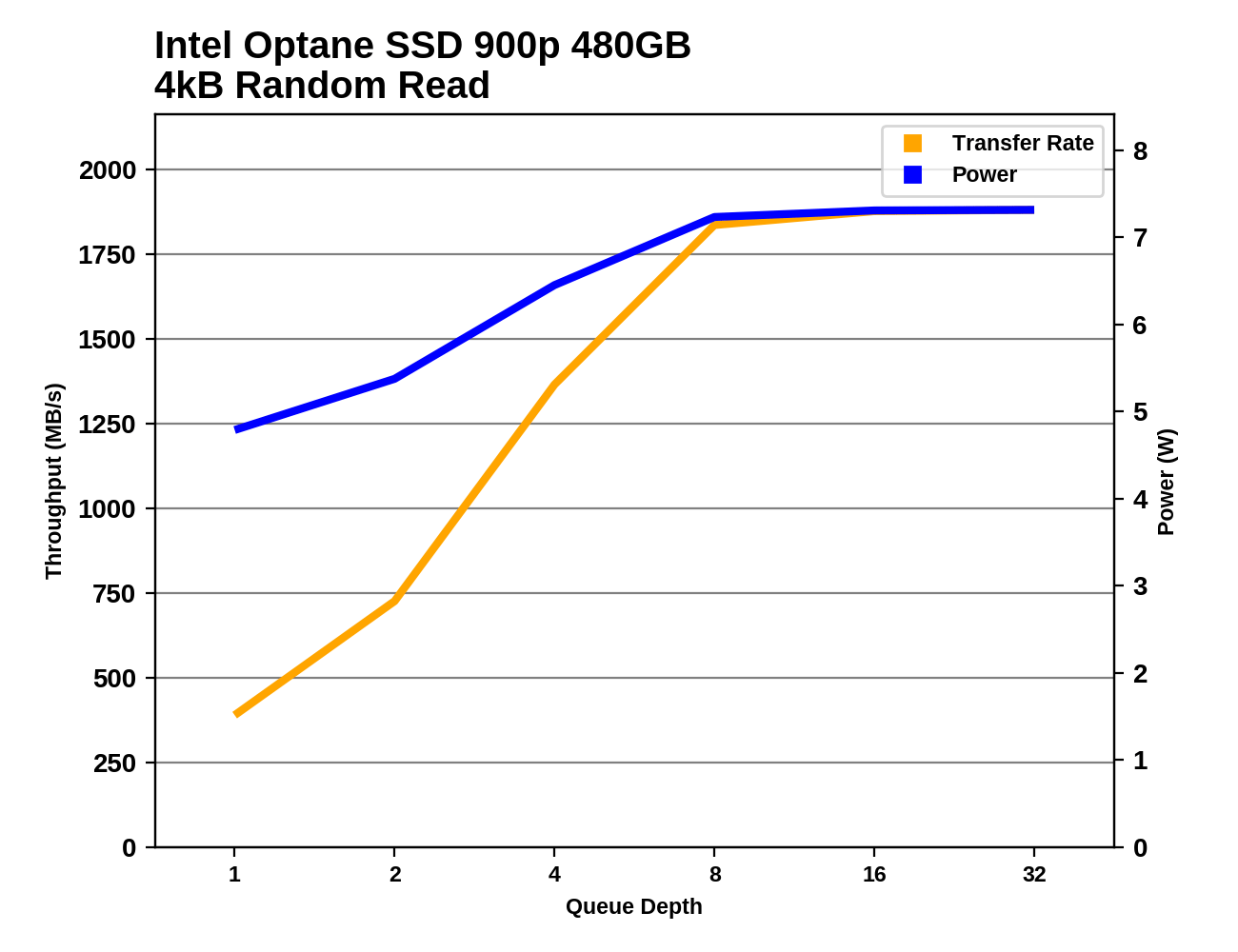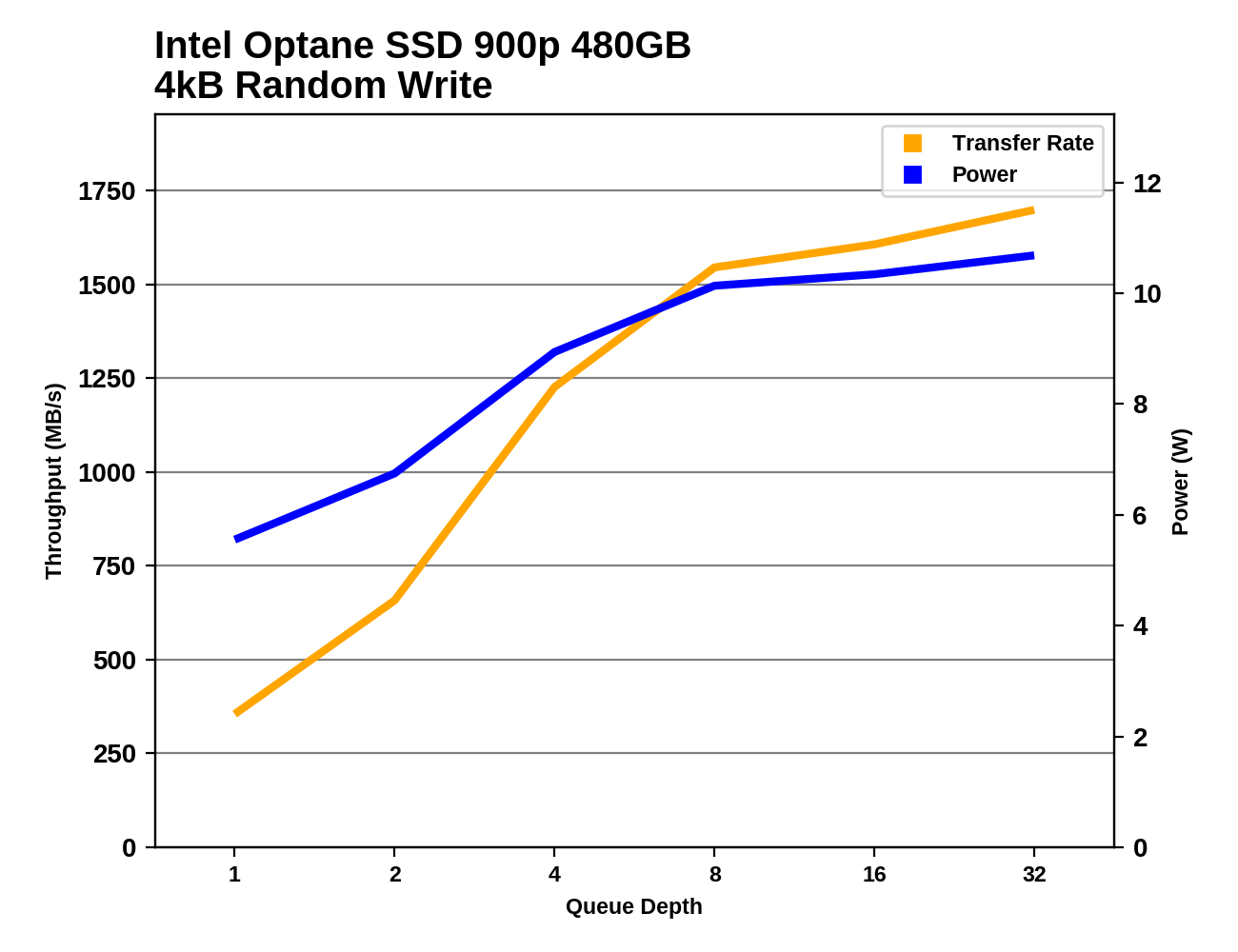The Intel Optane SSD 900p 480GB Review: Diving Deeper Into 3D XPoint
by Billy Tallis on December 15, 2017 12:15 PM ESTRandom Read Performance
Our first test of random read performance uses very short bursts of operations issued one at a time with no queuing. The drives are given enough idle time between bursts to yield an overall duty cycle of 20%, so thermal throttling is impossible. Each burst consists of a total of 32MB of 4kB random reads, from a 16GB span of the disk. The total data read is 1GB.

Random reads at queue depth 1 are where Intel's Optane products shine. Compared to the fastest NVMe SSDs using MLC NAND flash, the Optane SSDs aren't quite an order of magnitude faster, but only because the latency of the NVMe protocol over PCIe becomes the bottleneck. Intel's tiny Optane Memory M.2 cache drive is slightly faster in this one benchmark, but the difference hardly matters.
Our sustained random read performance is similar to the random read test from our 2015 test suite: queue depths from 1 to 32 are tested, and the average performance and power efficiency across QD1, QD2 and QD4 are reported as the primary scores. Each queue depth is tested for one minute or 32GB of data transferred, whichever is shorter. After each queue depth is tested, the drive is given up to one minute to cool off so that the higher queue depths are unlikely to be affected by accumulated heat build-up. The individual read operations are again 4kB, and cover a 64GB span of the drive.

Adding some higher queue depths to the average shows a small speed advantage for the 480GB Optane SSD over the 280GB model, and the Optane Memory M.2 starting to fall behind the larger Optane SSDs. The NAND flash-based SSDs also pick up speed as queue depths grow, but they need to go far beyond QD4 to catch up.

Given how thoroughly the Optane SSDs have shattered the record for random read performance, it's not too surprising to see them at the top of the charts for power efficiency when performing random reads. The 480GB Optane SSD is a bit less efficient than the smaller model because it has to power significantly more 3D XPoint memory chips with only a small performance boost to show for it. Compared to the flash-based SSDs, the Optane SSDs are only about 2.5 times more efficient, despite being about 7 times faster. The performance doesn't come for free.
 |
|||||||||
At low queue depths the two Optane SSDs offer nearly the same random read performance. When they both reach saturation at QD8, the 480GB model has slightly higher performance, and is drawing about 0.85W more power—a 13% power increase for a 7% performance boost.
Random Write Performance
Our test of random write burst performance is structured similarly to the random read burst test, but each burst is only 4MB and the total test length is 128MB. The 4kB random write operations are distributed over a 16GB span of the drive, and the operations are issued one at a time with no queuing.

The random write performance at queue depth 1 of the Optane SSDs is great, but not record-setting. Flash-based SSDs can cache write operations in their DRAM and report the command as complete before the data has actually made it to the flash memory. This means that for most flash-based SSDs the burst random write speed is more of a controller benchmark than a test of the storage itself. The Optane SSDs don't have large DRAM caches on the drive and are actually writing to the 3D XPoint memory almost as quickly as the Intel SSD 750 can stash the writes in its DRAM.
As with the sustained random read test, our sustained 4kB random write test runs for up to one minute or 32GB per queue depth, covering a 64GB span of the drive and giving the drive up to 1 minute of idle time between queue depths to allow for write caches to be flushed and for the drive to cool down.

With larger queue depths and test durations long enough to defeat any DRAM-based write caching and many SLC write caches, the Optane SSDs rise to the top. With this second round of testing, the 280GB Optane SSD performed slightly worse than the first run, but it's still essentially tied with the fastest flash-based SSDs. The 480GB model is a tiny bit faster than even the previous record from the 280GB model, putting it about 8% faster than the Samsung 960 PRO.

Without a huge performance lead, the high power consumption of the Optane SSDs takes a toll on their efficiency scores for random writes. They are ahead of early NVMe SSDs and on par with the fastest SATA SSDs, but the best current flash-based NVMe SSDs are substantially more efficient. The Toshiba XG5 prioritized efficiency over peak performance and ends up offering more than twice the power efficiency of the Optane SSDs, while the Samsung 960 EVO has a mere 77% efficiency advantage at essentially the same level of performance.
 |
|||||||||
As with random reads, the performance and power consumption gap between the two Optane SSD 900p capacities widens at higher queue depths. With power consumption starting at 5W and climbing to over 10W for the larger model, the Optane SSDs are in a completely different league from M.2 NVMe SSDs, which mostly top out around 4.5W.










69 Comments
View All Comments
thestryker - Friday, December 15, 2017 - link
I'm curious if the power consumption on the u.2 version would be any different.Any chances of Intel hooking AnandTech up with a u.2 version? I know the storage bench system doesn't have u.2, but I'm sure there's a system around which does. I believe there's also a sku with m.2 to u.2 adapter also.
Billy Tallis - Friday, December 15, 2017 - link
The U.2 drive uses the same 12V supply as the add-in card, unlike SATA SSDs that use 5V. Any differences in power consumption would probably be minor variations due to different operating temperature.CheapSushi - Friday, December 15, 2017 - link
It's been so satisfying to see all the Optane haters, dismissers, general naysayers and "meh, ___ is good enuff" crowd, who pretend to be enthusiasts, finally backtracking on their comments about it. Good times.tricomp - Saturday, December 16, 2017 - link
Can't wait seeing my customer's jaws dropping... I build heavy multi-core workstations for 3D and post production. Using 480 jet like this for the OS is something they will truly appreciatemapesdhs - Monday, December 18, 2017 - link
Responsiveness, etc. with pro apps wasn't tested here. Where's the evidence it would be any better than a 960 Pro? I'd be more interested in a Puget Systems review with real world situations.tricomp - Monday, December 18, 2017 - link
I agree with mapesdhs. The main strength of this unit should be tested and compared, not to mention - mentioned - in an article called "deeper diving into 3D Xpoint"lilmoe - Saturday, December 16, 2017 - link
Pardon the ignorance, but is can XPoint memory packages run on lower voltages, or is operation dependent on a single constant voltage setting? Are there any plans for low-power based XPoint like LPDDR or DDRL? If so, I wonder how much performance and latency would degrade.As it is, these will never be able to compete with NAND in terms of power. Lots of users (like) me want this kind of power on the go. Samsung and others are simply NOT trying anymore. I've REALLY delayed purchasing a mobile workstation till these technologies get sorted out and it's clear for me what type of expansion I'll need for compatibility.
wanderer66 - Saturday, December 16, 2017 - link
There won't be mainstream memory modules until late next year, based on what I've read. I wouldn't count on seeing mobile workstation/laptop capability until 2019 or 2020, and that depends on several things: 2nd or 3rd gen optane modules using less power (due to die shrinkage), and a reference design from Intel that supports them on that kind of motherboard. Even then count on them consuming 10-15 watts for a loaded configuration.wanderer66 - Saturday, December 16, 2017 - link
Two things: This is first gen Optane architecture. *First Gen* sisters and brothers... In the next several years, performance will evolve as the controllers improve (greater parallelism and other performance tweaks), power usage will decrease as process optimization and die shrinkage improves, and the design moves beyond being able to use NVMe as the interface, which it will.Second, 550k iops. That's mind-blowing, really. This may not be hugely important to single-user workstations, but in the hosting/cloud markets, this is one of the largest leaps that can be made..
In five years time, Optane will be to flash SSDs what flash SSDs are to HDDs today.
djayjp - Sunday, December 17, 2017 - link
Would *really* like to see real world testing, not traces. In such tests no difference is ever apparent between the bargain basement SSDs and the absolute top tier, thus the current tests AT uses are nonsense.